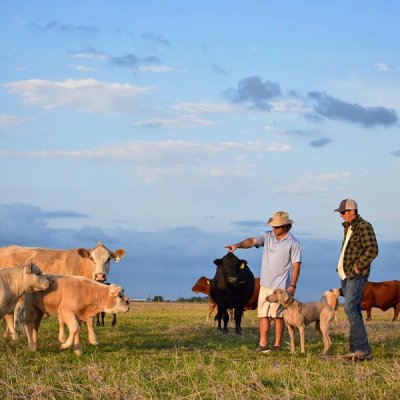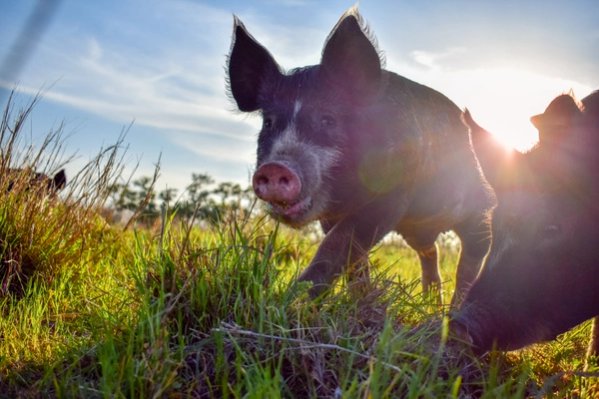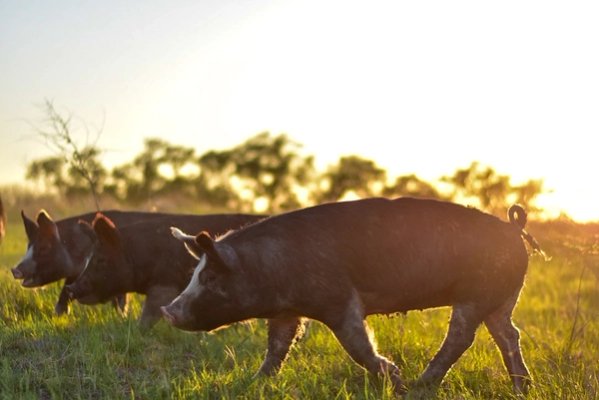I get this question often, and as an animal lover I probably would have been asking the same thing four years ago before becoming educated on the commodity meat system. My mom thought I would be a vet growing up, and I was the person in 4H that held my animal (goat) back as a pet because I couldn’t stand the thought of slaughtering it. For years, and long after I left the nest, my dad would walk this ex show goat, Pete, with the dogs down Glenoak road every day. And here I am, 13 years later, running a regenerative farm in Texas where animal slaughter is a key part of the equation. I’m sure you can see how much care and respect we have for these animals if you read our posts and weekly emails, or follow our stories. In order for me to explain handling my emotions on kill day, I need to take a couple steps back and talk about how most commodity meat is raised - and commodity meat is what the majority of Americans eat (even if it is labeled as organic, natural, or now “pasture raised”, as large scale and often times VC funded companies are starting to claim after seeing the demand for meat raised this way).

Meat is considered a commodity in America, just like crude oil, natural gas, coal, corn etc. Commodity has several definitions - “a mass produced unspecialized product”, “a good or service whose wide availability typically leads to smaller profit margins and diminishes importance of factors other than PRICE”. That my friends - combining PRICE with “feeding the world” mentality is what led America to raise living, breathing animals as cheaply as possible for meat. How do you raise meat as cheap as possible? Cram them together in big barns or feedlots (not land), feed them the cheapest grain possible, give them subtherapeutic antibiotics (daily/added to feed) and growth hormones (cattle) to make them grow faster. Cut your cost any way you can to increase your margins. It’s a dirty yet very real side of capitalism. What does this mean for the animal? It means the commodity system disassociates them from living organisms and views them as goods and products before they are even packaged as meat. Hogs never get to feel the dirt between their little cloven hooves, root around and eat roots or take a nap in the sunshine in a big mud wallow. Cattle raised in a feedlots don’t have grass or pasture to graze, even though as ruminants that is what their bodies are designed to digest. Chickens are raised in their own feces, where often times the farmer needs to wear a mask in the barn due to ammonia levels from the manure. Never having the chance to eat a bug or peck around and eat grass.

It is not okay friends. I am NOT OKAY with this. As a country, we should have never gotten to this point; the worst part is, animals can’t speak for themselves or fight for better conditions. I often wonder how consumers would purchase if the mindset of “not wanting to think about it” didn’t exist. Would livestock conditions have gotten so bad if there was more transparency inside the commodity meat system? Would consumers change their buying decisions if these companies were not allowed to use terms like “natural, organic, free range”, or put pictures of pastures on their packaging when in reality it’s often times very far from the truth? Would it change behaviors? It definitely changed ours, and we now gladly assume the burden of handling slaughter days. We do it because we know what the alternative looks like.


We honor these animals in life, and we honor them in death. We give them the chance the live to their fullest potential. While we don't look forward to their "few bad seconds", it doesn’t make me sad anymore. Driving past a feedlot or chicken barn is what makes me sad. That is when I get emotional, thinking about the animals that never got to really live. Wondering how we as a country have gotten to this point. Wondering who said “livestock raised like this is fine.” I don’t get attached to individual animals, but I am fiercely attached to the group as a whole and to our mission to change the way consumers view animals raised for meat. I know the way our livestock is raised. I honor these animals, and I'm proud to provide them with the very best life as nature intended until it's time to provide some of the best nourishment to all the families we feed.

The best part? There is another way, another system. We would be happy to ship you some of our grass fed and pasture raised meats from our Texas farm, or provide you with a great website to find a farm super close to you, wherever you might be. Take a look at eatwild.com - and thank you for being here.


Leave a comment